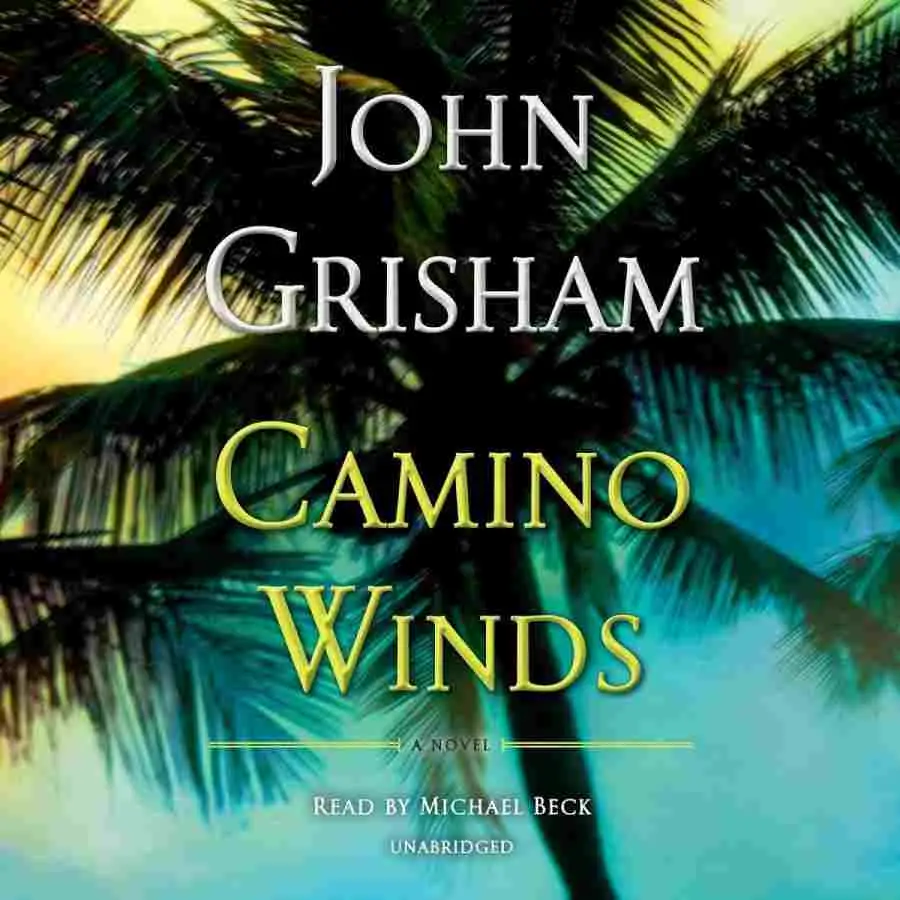

Books have always been my safe haven, particularly when the world outside is as crazy as a Grisham courtroom. My connection with John Grisham’s novels has lasted decades, and each new publication seems like a welcome, although exhilarating, reunion. When I first discovered Camino Winds, I was instantly reminded of the exhilaration I had when I first read The Firm—only this time, instead of the high-stakes world of law, Grisham brings us to the deceptively calm beaches of Camino Island. With Camino Winds, Grisham expertly mixes the tension of his legal thrillers with a new setting, evocative of a languid summer day with a dark undertone—an undercurrent that will eventually draw you in.
The Allure of Camino Island
Before delving into Camino Winds‘s dense narrative, it’s worthwhile to explore Grisham’s world-building. Camino Island is a character in and of itself, with its beaches, small-town charm, and eccentric population creating an enticing but sinister environment. This isn’t just any island; it’s one where secrets lie around every turn, and Grisham’s story keeps the reader continuously aware of this dichotomy.
In Camino Winds, Grisham returns to Camino Island, which he originally established in Camino Island, a story about the world of rare book theft. The reappearance of the island in Camino Winds is like catching up with an old friend, albeit one with a fresh tale to tell. The crossover from the rarefied realm of literary thievery to the murder mystery in Camino Winds is smooth, demonstrating that Grisham’s storytelling approach is adaptable enough to other genres while keeping the same degree of tension and interest.
Plot Summary: A Storm Brews
The narrative of Camino Winds opens with a genuine storm: Hurricane Leo, a violent hurricane heading near Camino Island. The locals are used to the odd tropical storm, but Hurricane Leo is different. It’s a monster, and the island is in its sights. The book’s protagonist, Bruce Cable, owner of Bay Books, is one of the few who chose to remain and weather the storm. Bruce is no average bookseller; he is a guy with a background, connections, and an insatiable curiosity—qualities that make him ideal for the mystery that is about to emerge.
Hurricane Leo devastates the island, leaving a path of ruin in its wake. However, the storm’s aftermath causes more than simply physical destruction. Nelson Kerr, Bruce’s friend and fellow writer, is discovered dead in his house after what looks to be a sad storm-related tragedy. However, when Bruce starts to put together the events surrounding Nelson’s death, it becomes evident that this was not an accident.
Character Dynamics: More Than Meets the Eye
One of Grisham’s writing skills is his ability to build multidimensional, approachable people. In Camino Winds, this is clear in the protagonist, Bruce Cable, who acts as both the story’s anchor and the reader’s glass through which to see the mystery. Bruce is a multifaceted character whose love of literature and the written word contrasted with his readiness to delve into the dark seas of amateur investigation. He’s a character who is happy with his existence on Camino Island, but he can’t resist the allure of a good mystery—especially one involving a buddy.
Nelson Kerr, while being dead for the most of the book, has a significant impact on the storyline. His existence as a writer of political thrillers mirrored the events that occur following his death. Bruce’s inquiry centers on Nelson’s last manuscript, a damning exposé of a corrupt pharmaceutical corporation. Through Nelson’s writing, Grisham addresses issues of corporate greed, corruption, and the extent that powerful organizations will go to defend their interests.
Supporting characters include Bob Cobb, a local fisherman and Bruce’s buddy, and Nick Sutton, a lawyer with a predilection for conspiracy theories, who give dimensions to the plot. They are more than simply supporting characters; they are essential to the inquiry, each offering their unique set of skills and eccentricities. Grisham’s ability to include these individuals into the tale without detracting from the major storyline demonstrates his expertise as storyteller.
The Mystery Unfolds: A Deep Dive into the Story
As Bruce looks more into Nelson’s murder, he discovers a labyrinth of deception, greed, and corruption that extends well beyond the borders of Camino Island. Nelson’s manuscript, which he was working on before to his death, is more than simply a book; it is a hazardous piece of evidence that might reveal a big pharmaceutical company’s illegal operations.
Grisham takes the reader on a tour into the realm of corporate corruption, delving into the darker side of the pharmaceutical business. Nelson’s paper discloses how, in order to increase revenues, the business cut costs on drug testing, resulting in dangerous side effects that were concealed. It’s a plot that seems straight from the headlines, a reminder of the real-world repercussions of corporate greed.
As Bruce and his pals investigate more, they realize that Nelson’s death was not an act of random violence, but rather a well planned murder disguised as an accident. The murders were professionals paid to silence Nelson before his book was published. As Bruce discovers the truth, the narrative takes unexpected turns, culminating in a stunning and rewarding ending.
Grisham’s narrative style is a blend of old and new
One of the most appealing parts of Camino Winds is how Grisham combines his traditional storytelling technique with a new locale and storyline. Long-time Grisham readers will recognize the characteristics that made his earlier works so successful—suspense, well-crafted characters, and complicated plot twists. However, Camino Winds demonstrates Grisham’s ability to adapt and innovate, moving away from the courtroom and into a more easygoing, but equally hazardous, setting.
Another notable aspect of the work is its tempo. Grisham understands how to create tension, utilizing the storm as a symbol for the impending battle. The hurricane’s approach reflects the increasing peril Bruce confronts as he comes closer to the truth. This comparison between natural and man-made disasters adds dimension to the plot, keeping the reader on edge until the finish.
Themes and Motifs: Not Just a Mystery
While Camino Winds is primarily a mystery book, it also delves into a number of other issues that provide complexity to the plot. One of the most significant topics is the concept of justice—specifically, who gets to define what justice looks like. Bruce and his buddies are not law enforcement officers; they are regular folks who have taken it upon themselves to pursue justice for Nelson. This vigilante-style approach calls into question the judicial system’s competence and ability to provide true justice in a society where power and money often control decisions.
Another recurring subject throughout the narrative is the corrupting impact of power. The pharmaceutical corporation at the core of the mystery exemplifies how power may be used to exploit and damage people. Grisham is unafraid to criticize businesses for going to great lengths to defend their interests, even if it means ruining people. This issue is especially pertinent in today’s society, as corporate scandals and unethical actions dominate headlines.
The concept of the island being both a paradise and a jail is particularly noteworthy. Camino Island, with its magnificent beaches and laid-back attitude, seems to be the ideal destination to get away from the stresses of everyday life. However, as the novel progresses, it becomes evident that the island’s remoteness may also be a trap, making it impossible for Bruce and his pals to seek assistance or flee the horrors they encounter. The island’s dual nature heightens the suspense by generating a sensation of claustrophobia.
Spoiler: The Climax and Resolution
As the tale progresses, the stakes become more high. Bruce, now persuaded that Nelson was killed, finds a sequence of clues that lead him to the assassins’ identities. The tension builds as Bruce confronts the persons responsible for his friend’s murder. Grisham’s handling of the final showdown is superb, combining action and psychological tension in a manner that keeps the reader turning the page.
Without giving away too much, the ending of Camino Winds is both rewarding and thought-provoking. Grisham does not wrap things up neatly; instead, he leaves the reader with unanswered concerns about justice, morality, and the cost of discovering the truth. It’s a satisfying finish that fits the plot and the complicated universe that Grisham has constructed.
Comparing Camino Winds with Other Grisham Works
In many aspects, Camino Winds differs from the traditional Grisham book, yet it also has certain commonalities with his earlier works. The most apparent parallel is with Camino Island, due to the similar environment and people. However, whereas Camino Island concentrated on the realm of rare books and literary intrigue, Camino Winds switches gears to investigate a murder investigation with larger consequences.
Another work by Grisham that springs to mind is The Reckoning, which dealt with issues of justice and the implications of exposing terrible truths. Both books contain heroes who are prepared to put everything on the line to find out the truth, even if it means fighting formidable foes. However, The Reckoningwas primarily a Southern Gothic tragedy.
Conclusion: A must-read for Grisham fans
Camino Winds is a lovely diversion from John Grisham’s usual fare, but it keeps all of the characteristics that make his works so compelling—strong people, sophisticated storylines, and a place that comes to life on the page. If you want a novel that blends the finest of mystery, suspense, and a touch of paradise, this is it.
As someone who has read innumerable novels and written numerous reviews, I can definitely state that Camino Winds is an excellent addition to Grisham’s outstanding body of work. It lacks the judicial excitement of his previous works, but it more than compensates with an intriguing location and a captivating narrative.
So, whether you’re a long-time Grisham fan or a beginner seeking for a fascinating book, Camino Winds will not disappoint. And if you’re like me, you’ll be looking forward to your next vacation to Camino Island.
Stay tuned for future reviews, for as long as there are books like this to find, I’ll be here to offer my ideas. Until the next time, enjoy reading!


